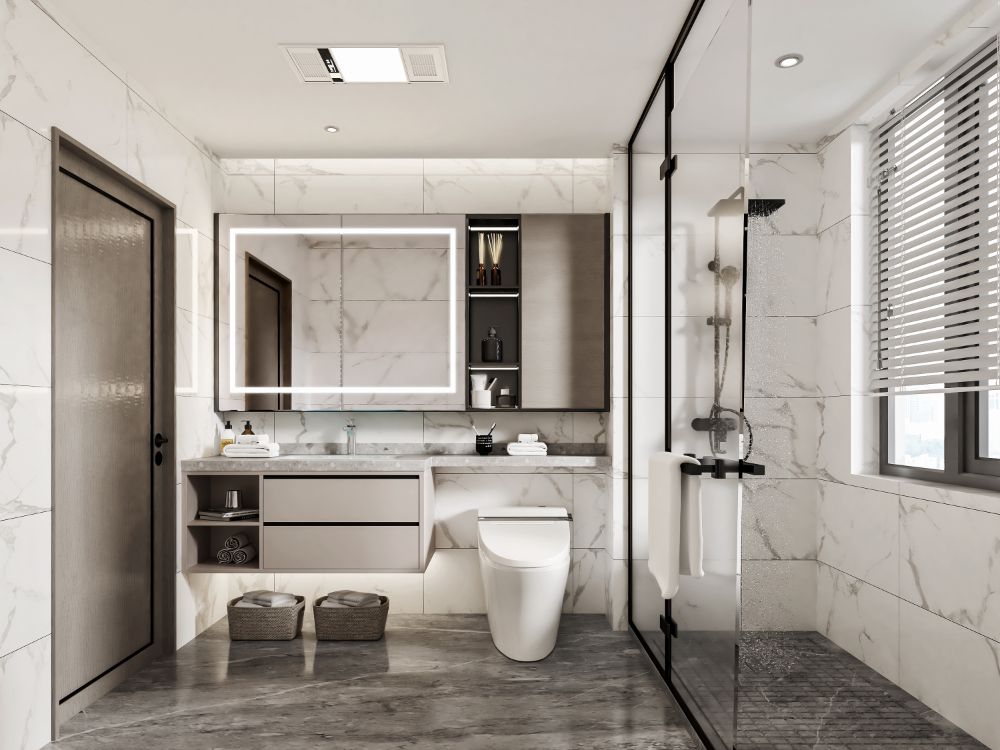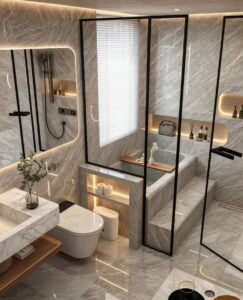Section I: Water Pressure Fundamentals and the Tankless Imperative
The contemporary smart toilet has evolved from simple gravity to sophisticated electro-mechanical systems. This transition, especially in tankless designs, imposes stringent requirements on home plumbing infrastructure. Meeting necessary water pressure thresholds is crucial for optimal performance, hygiene, and convenience.
Defining Smart Toilet Pressure Requirements: Dynamic vs. Static
The smart toilet requires consistent, pressurized water flow for features like power-assisted siphonic jet flush and bidet cleansing. Maximum static pressure is typically limited to 80 Psi , but the critical metric is the minimum dynamic operating pressure, set at 25 Psi for many high-efficiency models. Dynamic pressure, the pressure sustained during maximum flow (the flush cycle), is key. High static pressure (e.g., 60 Psi when idle) is irrelevant if dynamic pressure fails due to restrictions like narrow or corroded pipes. Tankless toilets require an instantaneous, high-volume surge, making flow capacity critical. Insufficient dynamic pressure results in weak flushing power.
The Unique Vulnerability of Tankless Systems
Tankless models (like T2005 or T2205-GTA ) lack an internal storage reservoir, making them entirely dependent on the home’s immediate supply pressure for both bidet functions and critical flushing. Insufficient domestic pressure leads to performance issues, classified as a compatibility issue, not a product defect. Buyers must confirm their water pressure before purchasing a tankless unit to avoid costly modifications. If the existing pressure is low, installation of a booster pump is mandatory for optimal function.
How Low Pressure Sabotages Smart Features
Low pressure compromises core features. The instantaneous water heating feature fails when low flow prevents heating elements from transferring thermal energy, resulting in insufficient bidet warmth or system shutdowns. Similarly, low pressure diminishes the bidet spray's strength, negating primary hygiene and comfort benefits.
Section II: Diagnosis and Immediate DIY Troubleshooting
When a smart toilet exhibits weak performance, diagnosis starts by isolating the pressure drop source.
Systemic vs. Localized Issue Determination
Start diagnostics by testing other home fixtures.
Systemic issues (low pressure house-wide) suggest problems like a faulty main pressure regulator, corroded pipes, or low municipal supply, requiring professional help.
Localized issues (only at the toilet) suggest minor, unit-specific problems. Leaks at connection points can be identified by checking joints with toilet paper.
Five Essential DIY Fixes for Weak Flow
-
Water Supply Valve Check: Ensure the angle stop valve is fully open.
-
Hose Inspection: Check the flexible hose for kinks or sharp bends.
-
Electronic Pressure Settings: Maximize the bidet pressure setting via the remote.
-
Power Cycle Reset: Unplug the unit for one minute to clear electronic errors.
-
Remote Control Functionality: Check the remote battery if the water temperature light flickers.
Critical Maintenance: Cleaning the Water Inlet Filter Screen
Clogging of the inlet filter screen is the most common cause of 1. Power off and shut off the water supply.
- Disconnect the main supply hose with a wrench.
- Use tweezers to extract the mesh screen filter, typically located at the pulse or flush valve inlet.
- Rinse the filter to remove debris (rust, dust).
- Reinstall the clean filter, secure the supply hose, and restore water/power.
Section III: Advanced Solution—Integrating Water Booster Pumps
When systemic low pressure (below 25 Psi dynamic ) is confirmed, a booster pump is mandatory.
Justification for a Boost Pump in Residential Settings
Booster pumps are deployed to solve chronic pressure deficits, ensuring the necessary hydraulic requirements are consistently met. They are mandatory for mitigating low community pressure, compensating for pressure loss in multi-story homes, or addressing deficiencies in older plumbing systems.
Comparative Analysis: Fixed Speed vs. Variable Speed Drive (VSD) Pumps
| 特点 | Fixed Speed Pump | Variable Speed Drive (VSD) Pump |
|---|---|---|
| Initial Cost | Lower | Higher |
| 能源效率 | Lower (Runs constantly at full capacity) | Higher (Adjusts speed to demand) |
| Operational Costs (Long-Term) | Higher due to constant energy use | Lower due to optimized performance |
| Response to Demand | Constant full flow, less optimized | Highly effective (Fine-tunes operational speed) |
| Acoustic Profile | Generally louder and constant | Quieter, speed adjusts to minimal requirement |
Fixed Speed Pumps have a lower initial cost but run constantly at full capacity , leading to high, steady energy consumption.
VSD (Variable Speed Drive) Pumps have a higher initial cost but adjust their speed to demand. This offers superior energy efficiency, lower running costs, and quieter operation , making VSD systems recommended for high-end smart toilets.
System Configuration: Integrated vs. External Solutions
-
Integrated Boosters: Small, internal pumps for minor pressure stabilization. Often insufficient for severe low-pressure conditions.
-
External Boosters: Larger systems requiring professional installation into the main supply line. Location must consider noise management.
Section IV: Power Loss Resilience—Mastering the Blackout Flush
Smart toilets rely on power for all features, creating a point of failure during grid outages. The Blackout Flush is a critical safety mechanism.
The Technology Behind Battery-Assisted Flushing
The Blackout Flush (emergency flush) uses an internal, stored power source (typically a replaceable battery pack ) to run motors for a forceful siphonic flush. This is an
emergency feature providing only one or two flushes. Premium toilets often include a final manual override lever for when battery power is depleted.
Essential Battery Maintenance and Replacement Protocol
The emergency function relies on a standard 9V battery or a proprietary pack.
Protocol: 1. Unplug the unit. 2. Locate the battery compartment (often at the rear, sometimes requiring seat removal ). 3. Install a new 9V battery. 4. Reassemble and consider annual preventative replacement due to bathroom moisture.
Section V: Optimizing Bidet Wash Pressure and Nozzle Performance
Weak bidet spray often comes from localized restrictions within the dedicated wash system.
Troubleshooting Low Bidet Flow
-
Clogged Spray Heads: Mineral deposits or sediment clog fine apertures. High-end models have self-cleaning functions , but manual cleaning may be needed in hard water areas.
-
Filters/Supply: Ensure dedicated wash inlet filters are clear and the supply lines are free of kinks.
Manual T-Valve Adjustment
If electronic pressure is maximized, some units allow mechanical fine-tuning at the T-valve (angle stop) under the toilet. Adjust the lever incrementally until the desired comfort is achieved.
Technology to Enhance Hygiene
-
Dual Water Flow Systems: Separate supply channels for the high-volume flush and the precise bidet wash. This prevents pressure draw-down and air blockages.
-
Instant Heating Technology: More hygienic and energy-efficient than water storage heating, but requires consistent water pressure to function correctly.
Section VI: Smart Toilet Water Pressure Specifications and Installation Checklist
Successful operation depends on adherence to hydraulic requirements.
Pre-Installation Checklist: Verifying Your Home’s Readiness
Table 2: Smart Toilet Hydraulic Requirements Checklist
| Measurement Type | Standard Function | Required Minimum | Maximum Limit | Impact of Non-Compliance |
|---|---|---|---|---|
| Dynamic Operating Pressure | Flush and Wash Power | 25 Psi | N/A | Weak or incomplete siphonic flushing and bidet performance |
| Static Water Pressure | System Integrity | N/A | 80 Psi | Risk of internal component damage, leaks, or valve failure |
| Flow Rate | Sustained Water Delivery | Model Specific (High) | N/A | Failure of instant heating; inadequate refill time |
Verifying the dynamic operating pressure of at least 25 Psi is non-negotiable for core functionality.
Ensuring Electrical and Plumbing Synergy
Optimal performance requires stable water pressure (plumbing) and a dedicated, safe electrical supply (electrical). Features like instant heating and the power-assisted flush require a significant, stable current. A GFCI/RCD protected, grounded connection is a safety imperative.
Conclusion: Ensuring Longevity and Reliability
Achieving peak smart toilet performance requires a proactive, technical approach. Diagnostics must focus on the critical 25 Psi minimum dynamic operating pressure for tankless models. When pressure is inadequate, a Variable Speed Drive (VSD) boost pump is the recommended, energy-efficient solution. Longevity is secured through preventative maintenance: scheduled cleaning of the water inlet filter and diligent replacement of the Blackout Flush battery to guarantee sanitation during outages. Adhering to these hydraulic and electrical specifications ensures maximum comfort and long-term reliability.
Frequently Asked Questions (FAQ)
Can low water pressure damage my smart toilet?
Low water pressure is typically a functional impediment rather than a damaging factor. It severely compromises primary features (weak flushing, poor bidet performance), but is unlikely to cause immediate mechanical failure. However, consistently running the unit under severe flow deficit could introduce long-term strain on internal pump mechanisms or heating elements.
How do I know if my water inlet filter needs cleaning?
A strong indicator is a sudden and localized drop in performance, affecting only the toilet's flushing or bidet pressure, while other household fixtures maintain normal pressure. If visible sediment, rust particles, or debris accumulation is noted on the mesh screen after extraction, cleaning is immediately necessary to restore flow.
Is a variable speed boost pump worth the extra initial cost?
Yes. The higher initial investment for a VSD pump is generally justified by the long-term operational benefits. VSD pumps adjust their operational speed precisely according to demand, resulting in significant savings through reduced energy consumption compared to fixed-speed pumps. Furthermore, VSD technology offers substantially quieter operation.
Why do some smart toilets have a dual water flow system?
Dual water flow systems are implemented to optimize performance and prevent hydraulic conflict. By separating the supply channels—one for the high-volume flush and one for the precise bidet wash—the system ensures that the instantaneous high demand of the flush does not diminish the pressure or temperature control required for the bidet function.
If the power is out, how many times can I use the blackout flush?
The flushing capacity during a power outage is strictly limited and depends heavily on the model and the size/type of the backup battery (often a standard 9V battery). The Blackout Flush feature is engineered solely for minimal, emergency sanitation, typically supporting only one or two power-assisted flushes. For extended outages, users must rely on any integrated manual override handles or levers for gravity-based flushing, if available.


